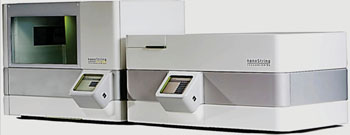Novel Multiplexed Digital Immunohistochemistry Used On Tissue Sections
By LabMedica International staff writers
Posted on 10 May 2016
Intratumoral heterogeneity has emerged as a critical challenge to the implementation of targeted therapeutics and immunohistochemistry (IHC) has been used to assess spatial heterogeneity of proteins; however, it has been difficult to quantify protein abundance at high multiplex and wide dynamic range.Posted on 10 May 2016
A spatially resolved, antibody-based proteomic approach has been developed with a “barcoding-potential” to quantify up to 800 targets in a single formalin-fixed paraffin-embedded (FFPE) slide. An assay has been developed capable of quantifying protein abundance in a predefined spatial region of a tissue section by labeling antibodies with photocleavable oligos, which are recognized by fluorescent barcodes and subsequently exposing them to focused UV light.

Image: The fully automated nCounter analysis system (Photo courtesy of NanoString Technologies).
Scientists at the MD Anderson Cancer Center (Houston, TX, USA) working with a commercial company slide-mounted FFPE tissue section bound with a multiplexed cocktail of primary antibody-oligo conjugates, and a microfluidic flow cell is attached to the slide. Using a simple modification of a standard microscope, regions of interest are identified by light or fluorescence microscopy and are sequentially illuminated with UV light to release the oligos. Following each illumination cycle, an eluent is collected and analyzed, resulting in digital counts that correspond to the abundance of each targeted protein in sequentially illuminated areas.
The antibodies were labeled with the collaborating commercial company’s nCounter fluorescent barcodes (NanoString Technologies, Seattle, WA, USA). The prototype includes imaging and fluidic components to capture spatial context, and existing nCounter instruments provide the quantification. Using a prototype device together with an nCounter Analysis System, the company and its collaborators demonstrated simultaneous counting of 30 different protein targets across a fixed, slide-mounted slice of tumor tissue.
Current multi-target IHC techniques involve sequential processing steps; therefore, each target addition increases the overall handling time and workload. In contrast, NanoString's novel technology samples all analytes simultaneously to shorten tests and simplify data analysis while preserving a higher multiplexing capacity and a wider detection range. The technology is expected to be compatible with current and upcoming nCounter Vantage products for 3D Biology analysis.
Joseph Beechem, PhD, Senior Vice President of R&D at NanoString said, “NanoString's new digital IHC technology combines the high multiplexing and digital quantification of single-molecule optical barcodes with the biological insights provided by protein localization. Over the remainder of this year, our plan includes increasing the number of targets in our assays, enhancing the imaging resolution and exploring use with other 3D Biology applications.” The study was presented at the American Association for Cancer Research (AACR) annual meeting, held April 16-20, 2016, in New Orleans (LA, USA).
Related Links:
MD Anderson Cancer Center
NanoString Technologies














